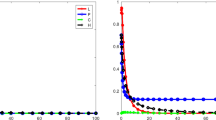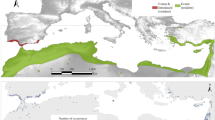Coupling of two Lotka–Volterra type competition systems with density-dependent migration was surveyed. We assumed that species x and y are each exclusively superior in subhabitat 1 and subhabitat 2, respectively, and that population densities that exert intra-and interspecific competitive effects also impose pressures for migration of individuals from a subhabitat. If the two species are, respectively, abundant in the subhabitats in which either species is competitively superior, and the migration has a mixing effect, then, it would be intuitively expected that, as potential migration rates increase, the two species are mixed well and coexist in the whole habitat. An analysis of this competitive situation using our model under the assumption of linear diffusion predicted that, even though weak mixing maintains coexistence in the whole habitat, strong mixing collapses coexistence and leads to the exclusion of one species. The assumption that migrations occur due to self- and cross-population pressures provides different predictions: (i) weak dominance and strong mixing destabilize the coexistence state and lead to a monopolizing equilibrium of either species (bi-stability of monopolizing equiliblia); (ii) conspicuous weakness of the inferior species makes the mixing equilibrium stable, regardless of the potential migration rate; and (iii) tri-stability exists in between situations (i) and (ii). In the third case, the attainable state is the mixing equilibrium or either of the monopolizing equilibria, depending on the initial state. Migration mechanisms with self- and cross-population pressures tends to mediate spatial segregation and makes coexistence possible, even with strong mixing.
Similar content being viewed by others
REFERENCES
Bertsch M., Gurtin M. E., Peletier L. A. (1984) On interacting populations that disperse to avoid crowding: The effect of a sedentary cology. Journal of Mathematical Biology 19: 1–12.
Crisp D. T. (1993) Population densities of juvenile trout (Salmo trutta) in five upland streams and their effects upon growth, survival and dispersal. Journal of Applied Ecology 30: 759–771.
Flebbe P. A. (1994) A regional view of the margin: Salmonid abundance and distribution in the southern Appalachian Mountains of North Carolina and Virginia. Transactions of the American Fisheries Society 123: 657–667.
Fonseca D. M. & Hart D. D. (1996) Density-dependent dispersal of black fly neonates is mediated by flow. Oikos 75: 49–58.
Gause G. F. (1934) The Struggle for Existence. Williams & Wilkins, Baltimore.
Gotelli N. J. (1998) A Primer of Ecology. Sinauer Associates, Sunderland.
Hastings A. (1996) What equilibrium behavior of Lotka–Volterra models does not tell us about food webs. In: Food Webs (eds G. A. Polis & K. O. Winemiller) 211–217 Chapman & Hall, New York.
Hughes J. B. & Roughgarden J. (1998) Aggregated community properties and the strength of species’ interactions. Proceedings of the National Academy of Science 5: 6837–6842.
Huisman J. & Weissing F. J. (1999) Biodiversity of plankton by species oscillations and chaos. Nature 402: 407–410.
Hutchinson G. E. (1961) The paradox of the plankton. American Naturalist 95: 137–145.
Kingsland S. E. (1985) Modeling Nature. University of Chicago Press, Chicago.
Lack D. (1971) Ecological Isolation in Birds. Blackwell Science, Oxford.
Larson G. L., Moore S. E., Carter B. (1995) Ebb and flow of encroachment by nonnative rainbow trout in a small stream in the southern Appalachian Mountains. Transactions of the American Fisheries Society 124: 613–622.
Lawton J. H. & Hassel M. P. (1981) Asymmetrical competition in insects. Nature 289: 793– 795.
Levin S. (1974) Dispersion and population interactions. American Naturalist 108: 207–228.
Lotka A. J. (1925) Elements of Physical Biology. Williams & Wilkins, Baltimore.
MacArthur R. H. (1958) Population ecology of some warblers of northeastern coniferous forests. Ecology 39: 599–618.
MacArthur R. H. (1972) Geographical Ecology. Princeton University Press, New Jersey.
MacArthur R. H. & Levins R. (1967) The limiting simularity, convergence and divergence of coexisting species. American Natruralist 101: 377–385.
Magoulick D. D. & Wilzbach M. A. (1997) Microhabitat selection by native brook trout and introduced rainbow trout in a small Pennsylvania stream. Journal of Freshwater Ecology 12: 607–614.
May R. M. (1972) On relationships among various types of population models. American Naturalist 107: 46–57.
Mimura M.-I. & Fang Q. (1991) Effect of domain-shape on coexistence problems in a competition-diffusion system. Journal of Mathematical Biology 29: 219–237.
Mimura M. & Kawasaki K. (1980) Spatial segregation in competitive interaction-diffusion equations. Journal of Mathematical Biology 9: 49– 64.
Nagel J. W. (1991) Is the decline of brook trout in the Southern Appalachians resulting from competitive exclusion and/or extinction due to habitat fragmentation? Journal of the Tennessee Academy of Science 66: 141–144.
Namba T. (1989) Competition for space in a heterogeneous environment. Journal of Mathematical Biology 27: 1–16.
Okubo A. (1980) Diffusion and Ecological Problems: Mathematical Models. Springer, Berlin.
Pao C. V. (1981) Coexistence and stability of a competition-diffusion system in population dynamics. Journal of Mathematical Analysis and Applications 83: 54–76.
Park T. (1962) Beetles, competition and populations. Science 138: 1368–1375.
Shigesada N., Kawasaki K., Teramoto E. (1979) Spatial segregation of interacting species. Journal of Theoretical Biology 79: 83–99.
Strange R. J. & Habera J. W. (1998) No net loss of brook trout distribution in areas of sympatry with rainbow trout in Tennessee streams. Transactions of the American Fisheries Society 127: 434–440.
Takeuchi Y. (1989) Diffusion-mediated persistence in two-species competition Lotka–Volterra model. Mathematical Biosciences 95: 65–83.
Tilman D., Mattson M., Langer D. (1981) Competition and nutrient kinetics along a temperature gradient: an experimental test of a mechanistic approach to niche theory. Limnology and Oceanography 26: 1020–1033.
Wolfram S. (1996) Mathematica Book. Cambridge University Press, Cambridge.
Yodzis P. (1989) Introduction to Theoretical Ecology. Harper & Row, New York.
Yodzis P. (1996) Food webs and perturbation experiments: theory and practice. In: Food Webs (eds G. A. Polis & K. O. Winemiller) 192–200 Chapman & Hall, New York.
Author information
Authors and Affiliations
Corresponding author
About this article
Cite this article
Nishimura, K., Kishida, O. Coupling of two competitive systems via density dependent migration. Ecol Res 16, 359–368 (2001). https://doi.org/10.1046/j.1440-1703.2001.00401.x
Received:
Accepted:
Issue Date:
DOI: https://doi.org/10.1046/j.1440-1703.2001.00401.x




